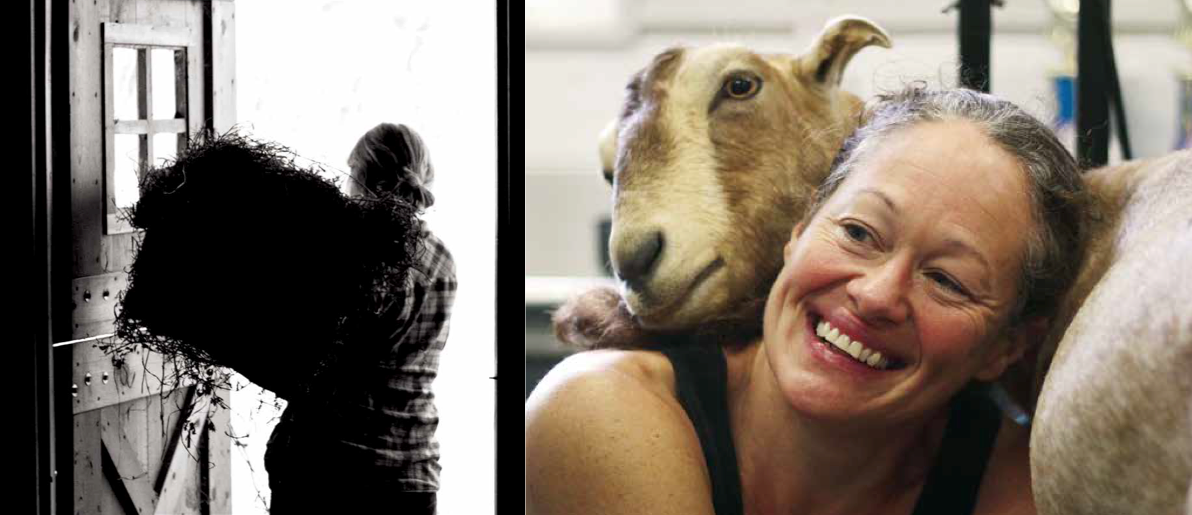FarmHer: Capturing Women's Central Role in Farming
Over 100 million Americans were tuned to the Super Bowl in February 2013 when it happened. It was during the fourth quarter, and I must have been the only one of those 100 million who was heading to the refrigerator for a beer because I think I’m the only one who missed it. And it had nothing to do with the game.
Actually, as I sat down, I heard the end of it. Radio broadcaster Paul Harvey’s voice--a blast from the past for sure--said, “and so God made a farmer.” The beginning of the ad had God making a farmer on the eighth day of creation. Harvey’s voiceover was a reading of a speech from the 70‘s he made to the FFA which extolled the many virtues of farmers. The ad was sprinkled with and closed with an image of a Dodge Ram pickup.
Apparently the ad was more memorable than the game, because the following entire week the media was abuzz about it. Using evocative and beautiful photographs of what certainly appear to be real ranchers and farmers, and Harvey’s voiceover embedded in the biblical narrative of the creation story in Genesis, Harvey elevated farmers in the American psyche in a remarkable way. And in a brilliant, perhaps never bettered Madison Avenue slight of hand, by having God make a farmer on the eighth day, he must have made Dodge Ram pickups on the ninth.
While America loved the ad--particularly those who are farmers or live in farming communities, one person saw it differently. Photographer Marji Guyler-Alaniz of Urbandale, a suburb of Des Moines, was already troubled by the lack of depictions of women as farmers in the media. Living in Iowa, she knows that women play a central role in farming, but she believes by and large the media have missed it. The Dodge ad drove the point home, as very few women were depicted in the ad, and their representation was more passive than that of the male farmers presented.
So she decided to do something about it, and mainly through word of mouth contacted a number of women farmers who agreed to be photographed. The result is the wonderful selection of images presented on the site www.FarmHer.com.
I first became aware of the FarmHer project on Facebook. It was a photograph on the page of my friend Lois Reichert, proprietor of Reichert’s Dairy Aire, an award winning artisanal goat cheese operation south of Knoxville that alerted me to the project. The image was stunningly beautiful, intimate, and compelling. In the images of Lois we not only see her beauty, but also her strength and passion for her work. And we see this in all of the images of other FarmHers in the collection as well.
The FarmHer photographs are interestingly different than those in the Dodge commercial. The photos of the farmers in the Dodge ad are reminiscent of the iconic posed Walker Evans and Dorothea Lange’s depression era photographs of farmers. Real people, worn people, who are looking into the camera in such a way as you get a glimpse of their souls. Only rather than desperation in the Evans and Lange photos, one sees hope and pride in the Dodge ads. Guyler-Alaniz photographic approach is quite different, yet equally stunning. Very little is posed, and she captures the essence of work. Lifting, pushing, and pulling, these women are active. They are strong too, and their bodies reflect the contours of their work. Work clothes also play a role in the photos, and those of us who know farmers know that they may well be wearing t-shirts and running shoes just like the rest of us.
I asked Marji if she thought that it made a difference in that she is a woman photographing women, and she paused before she said “maybe.” However, there is a comfort level that I see in the relationship between the FarmHers and Marji that I believe just might not be there if it were a male photographer. I see a sense of trust, and a feeling that laughter just might be around the corner--either forward or back. There is a twinkle in their eyes, and dare I say it--even a girlishness expressed--no matter the FarmHer’s age.
I asked Lois Reichert what it was like being one of the very first FarmHers, and what she feels about the project.
“Well, as one of her first subjects, I was impressed with her idea, and I love watching the success of the project, especially given that her goals at the beginning were so modest. Marji wasn’t afraid to get right in there with the goats and her eye for composition is amazing. She is a special woman with a great idea and she has made us all feel beautiful while capturing the passion we all have.” Looking at the images of Lois, and having been at her farm many times, one can easily that she has a very close relationship with her goats. But it’s not just Lois. Animals, vegetables, cheeses, and all of the products that the women create are clearly represented in the photographs almost as if they were cleaved to the women themselves, joined in some way.
Marji’s few photographs that are posed often have the product presented to the camera, almost like a gift. Carrots pass from one hand to another. A girl presents a turkey to the camera. From Honey Creek Creamery in the Loess Hills of western Iowa, the wheel of cheese in the photograph here seems as if presented as a gift to the reader.
I’m sure that every FarmHer wants to make money from her operation. Yet, these are not assembly-line farming operations minimizing inputs and maximizing profits that is modern corporate agriculture. It’s different for the FarmHers. It’s by hand, it’s local, and much of the time it is for people that they know, and many of whom they both know and love. Families. Neighbors. People down the street or in the next county.
It’s an uphill battle fighting corporate agriculture, but if our food is ever to be more healthy, more local, and sustainable, the FarmHers here and everywhere else they live and grow food are going to be at the forefront of that revolution.
It’s also going to be an uphill battle for Marji in changing how the corporate media and Madison Avenue depict farmers. But Marji makes a good point, telling me “women are starting their own farms all over the place, and women are the fastest growing demographic in agriculture. I think we’ll see a lot of changes in the coming years about how the media portrays farmers. I hope so.”
And if that revolution ever takes place, Marji and her FarmHers are going to be at the forefront. Maybe they already are.
For more about FarmHer and the photography of Marji Guyler-Alaniz, simply turn the page, or visit FarmHer.com




